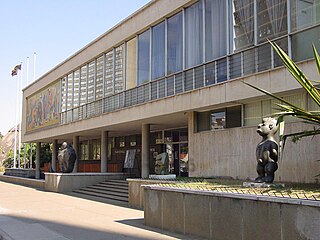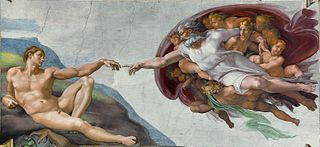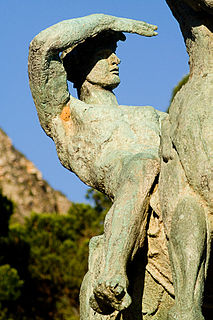
The Ark of the Covenant also known as the Ark of the Testimony, and in a few verses across various translations of the Bible as the Ark of God, is a gold-covered wooden chest with lid cover described in the Book of Exodus as containing the two stone tablets of the Ten Commandments. According to New Testament Book of Hebrews, it also contained Aaron's rod and a pot of manna.

Harare is the capital and most populous city of Zimbabwe. The city proper has an area of 960.6 km2 (371 mi2) and a population 2,123,132 in the 2012 census and an estimated 3,120,917 in its metropolitan area in 2019. Situated in north-eastern Zimbabwe in the country's Mashonaland region, Harare is a metropolitan province, which also incorporates the municipalities of Chitungwiza and Epworth. The city sits on a plateau at an elevation of 1,483 metres above sea level and its climate falls into the subtropical highland category.
The Lemba, wa-Remba, or Mwenye are a Bantu ethnic group which is native to Zimbabwe and South Africa, with smaller, little-known branches in Mozambique and Malawi. According to Tudor Parfitt, then Professor of Modern Jewish Studies at the University of London, in the 1980s when he did his first fieldwork among the Lemba, in South Africa, Zimbabwe and Malawi they numbered an estimated 50,000. They speak the Bantu languages spoken by their geographic neighbours and resemble them physically, but they have some religious practices and beliefs similar to those in Judaism and Islam. According to Parfitt the Lemba claimed once to have had a book which contained their traditions but it was lost.

The University of Zimbabwe (UZ) is a public university in Harare, Zimbabwe. It opened in 1952 as the University College of Rhodesia and Nyasaland, and was initially affiliated with the University of London. It was later renamed the University of Rhodesia, and adopted its present name upon Zimbabwe's independence in 1980. UZ is the oldest and best ranked university in Zimbabwe.

Bulawayo is the second largest city in Zimbabwe, and the largest city in the country's Matabeleland region. The city's population is disputed; the 2012 census listed it at 653,337, while the Bulawayo City Council claimed it to be about 1.2 million. Bulawayo covers an area of about 1,707 square kilometres in the western part of the country, along the Matsheumhlope River. Along with the capital Harare, Bulawayo is one of two cities in Zimbabwe that is also a province.

The stone-carved Zimbabwe Bird is the national emblem of Zimbabwe, appearing on the national flags and coats of arms of both Zimbabwe and Rhodesia, as well as on banknotes and coins. It probably represents the bateleur eagle or the African fish eagle. The bird's design is derived from a number of soapstone sculptures found in the ruins of the ancient city of Great Zimbabwe.

According to the Hebrew Bible, the Tablets of the Law as they are widely known in English, or Tablets of Stone, Stone Tablets, or Tablets of Testimony in the Exodus 34:1, were the two pieces of stone inscribed with the Ten Commandments when Moses ascended biblical Mount Sinai as written in the Book of Exodus.
The National Sports Stadium is a multi-purpose stadium, in Harare, Zimbabwe, with a maximum capacity of 60,000 people. It is the largest stadium in Zimbabwe. Located in Harare just a Few meters from Heroes Acre. It is used mostly for football matches, but is also used for rugby union. Association football club CAPS United F.C. use the venue, which opened in 1987, for most of their home games.
Manyame Air Base is one of the two main air bases for the Air Force of Zimbabwe. Formerly known as New Sarum Air Force Station, Manyame Air Base is situated in Harare and is the principal air force establishment and provides facilities for aircraft squadrons of differing roles, training schools for technicians, staff and academic training and security dog handlers. A full range of amenities, which include workshops, transport fleets, equipment depots, accommodation, sports and entertainment facilities, support the base. Located on the same grounds as the Harare International Airport and sharing the same runway, it is home to these squadrons. It also houses the technical training school and the dog training unit. The base has a hospital and is surrounded by farmland as it is located on the outskirts of the capital city. It uses the same facilities as Harare International Airport:

Tapfuma Gutsa is a Zimbabwean sculptor.
Square Chikwanda is a Zimbabwean sculptor, living and working in Harare, Zimbabwe. He first learned his art from his father, also a Zimbabwean sculptor.
St. Ignatius College is a Jesuit, Catholic, boarding high school near Harare, Zimbabwe. It was founded as the brother institution for St George's College,Harare and from 1962 to 1971 it was all-male however the nuns of Congregation Jesu helped bring female scholars only for Advanced Level. The College's sister school is nearby St Dominic's Secondary School which meets frequently for social and co-curricula events. In its 59 years of inception it has garnered a name as the hub of profound education maintaining a hold within the top ten list of the national examinations. It linked to St Ignatius' College in England in its founding (1962) and has continuing links to St Augustine, Edinburgh, and Boston College, Massachusetts. Its traditional rival is St Francis Xavier's Kutama College.
Mount Pleasant is a residential suburb of Harare, Zimbabwe, located in the northern part of the city. Originally a farm, the area was developed for housing in the early 20th-century and was a white suburb until Zimbabwe's independence in 1980. Today, Mount Pleasant is a multiracial community and is one of Harare's more affluent suburbs.
Emerald Hill is a north-western suburb of Harare, Zimbabwe, named so because of either (i) the colour of the hill due to the large number of trees or (ii) an Irish connection: many of the roads in the suburb have Irish names.

The National Gallery of Zimbabwe (NGZ) is a gallery in Harare, Zimbabwe, dedicated to the presentation and conservation of Zimbabwe's contemporary art and visual heritage. The original National Gallery of Rhodesia was designed and directed by Frank McEwen, a British citizen credited with bringing Shona Sculpture to the spotlight. The Gallery was officially opened by Queen Elizabeth The Queen Mother on 16 July 1957 and Queen Elizabeth II attended the sixth Zimbabwe Heritage Exhibition there in October 1991.
Tudor Parfitt is a British historian, writer, broadcaster, traveller and adventurer. He specialises in the study of Jewish communities around the world, particularly in Africa, Asia and the Americas. Some of these communities have been recognised only since the late 20th century as having ancient Jewish origins.
Queen Victoria Museum may refer to:

A creationist museum is a facility that hosts exhibits which use the established natural history museum format to present a young Earth creationist view that the Earth and life on Earth were created some 6,000 to 10,000 years ago in six days. These facilities generally promote pseudoscientific Biblical literalist creationism and contest evolutionary science, which has led to heavy criticism from the scientific community.

Physical Energy is a bronze equestrian statue by English artist George Frederic Watts. Watts was principally a painter, but also worked on sculptures from the 1870s. Physical Energy was first cast in 1902, two years before his death, and was intended to be Watts's memorial to "unknown worth". Watts said it was a symbol of "that restless physical impulse to seek the still unachieved in the domain of material things". The original plaster maquette is at the Watts Gallery, and there are four full-size bronze casts: one in London, one in Cape Town, one in Harare and one soon to be sited at Watts Gallery - Artists' Village in Compton, Surrey. Other smaller bronze casts were also made after Watts's death.











